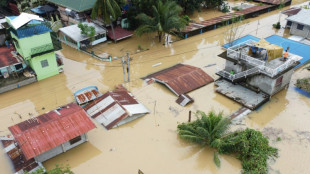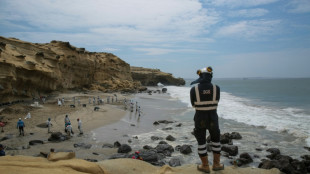
-
 Gaza hospital shut after Israeli raid, director held: health officials
Gaza hospital shut after Israeli raid, director held: health officials
-
Surgery for French skier Sarrazin 'went well': federation

-
 Mitchell, Bracewell boost New Zealand in Sri Lanka T20
Mitchell, Bracewell boost New Zealand in Sri Lanka T20
-
Kyrgios says tennis integrity 'awful' after doping scandals

-
 S. Korean prosecutors say Yoon authorised 'shooting' during martial law bid
S. Korean prosecutors say Yoon authorised 'shooting' during martial law bid
-
Vendee Globe skipper Pip Hare limps into Melbourne after dismasting

-
 Reddy's defiant maiden ton claws India back into 4th Australia Test
Reddy's defiant maiden ton claws India back into 4th Australia Test
-
Doubles partner Thompson calls Purcell doping case 'a joke'

-
 Reddy reaches fighting maiden century for India against Australia
Reddy reaches fighting maiden century for India against Australia
-
Sabalenka enjoying 'chilled' rivalry with Swiatek

-
 Political turmoil shakes South Korea's economy
Political turmoil shakes South Korea's economy
-
New mum Bencic wins first tour-level match since 2023 US Open

-
 'Romeo and Juliet' star Olivia Hussey dies aged 73
'Romeo and Juliet' star Olivia Hussey dies aged 73
-
Brown dominates as NBA champion Celtics snap skid

-
 Indian state funeral for former PM Manmohan Singh
Indian state funeral for former PM Manmohan Singh
-
France asks Indonesia to transfer national on death row

-
 Ambitious Ruud targets return to top five in 2025
Ambitious Ruud targets return to top five in 2025
-
Late bloomer Paolini looking to build on 'amazing' 2024

-
 Australia remove Pant, Jadeja as India reach 244-7 at lunch
Australia remove Pant, Jadeja as India reach 244-7 at lunch
-
Scheffler sidelined by Christmas cooking injury

-
 Rice seeks trophies as Arsenal chase down 'full throttle' Liverpool
Rice seeks trophies as Arsenal chase down 'full throttle' Liverpool
-
Trump asks US Supreme Court to pause law threatening TikTok ban

-
 Arsenal edge past Ipswich to go second in Premier League
Arsenal edge past Ipswich to go second in Premier League
-
LawConnect wins punishing and deadly Sydney-Hobart yacht race

-
 Ronaldo slams 'unfair' Ballon d'Or result after Vinicius snub
Ronaldo slams 'unfair' Ballon d'Or result after Vinicius snub
-
Several wounded N.Korean soldiers died after being captured by Ukraine: Zelensky

-
 Fresh strike hits Yemen's rebel-held capital
Fresh strike hits Yemen's rebel-held capital
-
Netflix with Beyonce make splash despite NFL ratings fall

-
 Bird flu mutated inside US patient, raising concern
Bird flu mutated inside US patient, raising concern
-
Slovakia says ready to host Russia-Ukraine peace talks

-
 Maresca challenges Chelsea to react to Fulham blow
Maresca challenges Chelsea to react to Fulham blow
-
Tech slump slays Santa rally, weak yen lifts Japan stocks higher

-
 Test records for Zimbabwe and Williams as Afghanistan toil
Test records for Zimbabwe and Williams as Afghanistan toil
-
LawConnect wins punishing Sydney-Hobart yacht race

-
 Barca's Yamal vows to 'come back better' after ankle injury
Barca's Yamal vows to 'come back better' after ankle injury
-
Olmo closer to Barcelona exit after registration request rejected

-
 Watching the sun rise over a new Damascus
Watching the sun rise over a new Damascus
-
Malaysia man flogged in mosque for crime of gender mixing

-
 Montenegro to extradite crypto entrepreneur Do Kwon to US
Montenegro to extradite crypto entrepreneur Do Kwon to US
-
Brazil views labor violations at BYD site as human 'trafficking'

-
 No extra pressure for Slot as Premier League leaders Liverpool pull clear
No extra pressure for Slot as Premier League leaders Liverpool pull clear
-
Tourists return to post-Olympic Paris for holiday magic

-
 'Football harder than Prime Minister' comment was joke, says Postecoglou
'Football harder than Prime Minister' comment was joke, says Postecoglou
-
Driver who killed 35 in China car ramming sentenced to death

-
 Bosch gives South Africa 90-run lead against Pakistan
Bosch gives South Africa 90-run lead against Pakistan
-
French skier Sarrazin 'conscious' after training crash

-
 NATO to boost military presence in Baltic after cables 'sabotage'
NATO to boost military presence in Baltic after cables 'sabotage'
-
Howe hopes Newcastle have 'moved on' in last two seasons

-
 German president dissolves parliament, sets Feb 23 election date
German president dissolves parliament, sets Feb 23 election date
-
Slot says 'too early' for Liverpool title talk

| RBGPF | 100% | 59.84 | $ | |
| CMSD | -0.67% | 23.32 | $ | |
| NGG | 0.66% | 59.31 | $ | |
| SCS | 0.58% | 11.97 | $ | |
| RIO | -0.41% | 59.01 | $ | |
| BTI | -0.33% | 36.31 | $ | |
| BP | 0.38% | 28.96 | $ | |
| CMSC | -0.85% | 23.46 | $ | |
| BCC | -1.91% | 120.63 | $ | |
| AZN | -0.39% | 66.26 | $ | |
| VOD | 0.12% | 8.43 | $ | |
| RYCEF | 0.14% | 7.27 | $ | |
| JRI | -0.41% | 12.15 | $ | |
| RELX | -0.61% | 45.58 | $ | |
| GSK | -0.12% | 34.08 | $ | |
| BCE | -0.93% | 22.66 | $ |

'Hot and dangerous weekend': US bakes under relentless heat dome
Brutally high temperatures threatened tens of millions of Americans Saturday, as numerous cities braced to break records under a relentless heat dome that has baked parts of the country all week.
The National Weather Service warned of an "extremely hot and dangerous weekend," with daytime highs routinely ranging between 10 and 20 degrees Fahrenheit above normal in the American West.
Residents of central and southern California, for example, could expect to see thermometers peaking at 100 to 110 degrees Fahrenheit (38 to 43 degrees Celsius), it said.
The heat is forecast to remain anchored over the West for the weekend, "growing hotter in the South by early next week."
Authorities have been sounding the alarm for days, advising people to avoid outdoor activities in the daytime and to be on the watch for signs of dehydration, which can quickly become fatal in such temperatures.
In the hardest-hit areas, residents face a daily endurance marathon against the sun.
The Arizona state capital of Phoenix has recorded 15 straight days above 109 degrees Fahrenheit (43 degrees Celsius), with Saturday expected to reach well above that mark.
In Houston, residents have been asked to begin conserving energy from 2:00 to 10:00 pm Saturday through Monday, in an attempt by provider Reliant Energy to mitigate high demand.
One local news station in the city, KPRC, heralded the prospect of "finally seeing an end to this heat wave" -- but only by "Sunday of next week."
Heat waves are occurring more often and more intensely in major cities across the United States, according to the federal Environmental Protection Agency, with a frequency of six per year during the 2010s and 2020s compared to two per year during the 1960s.
California's famous Death Valley, one of the hottest places on Earth, is also likely to reach new peaks on Sunday, with the mercury possibly rising to 130 Fahrenheit (54 Celsius).
Smoke from wildfires in western Canada, meanwhile, was creating unhealthy air quality conditions in parts of the upper-central United States -- similar to episodes in June when blazes in the Canadian province of Quebec cloaked the US East Coast in a noxious haze.
While it can be hard to attribute a particular weather event to climate change, scientists insist that global warming -- linked to humanity's dependence on fossil fuels -- is responsible for the multiplication and intensification of heat waves in the world.
The US heatwave comes after the EU's climate monitoring service said the world saw its hottest June on record last month.
F.Moura--PC




